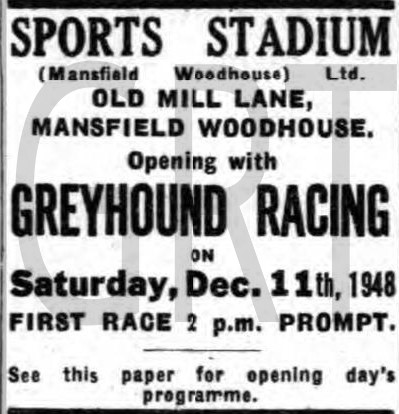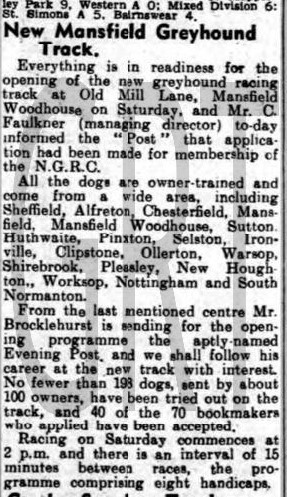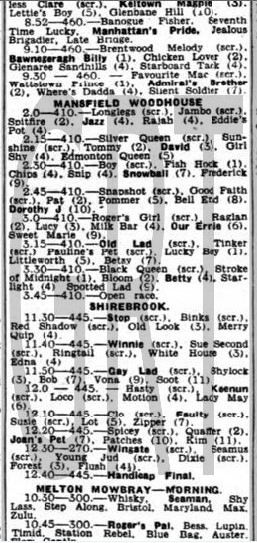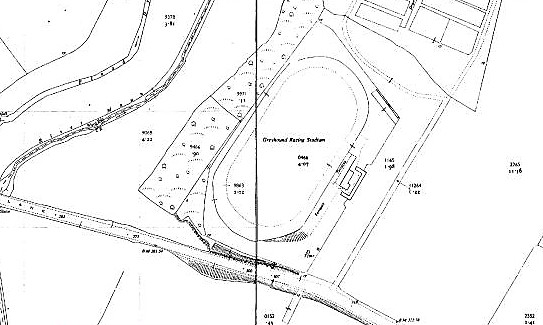Old Mill Lane, Forest Town, Nr Mansfield, Nottinghamshire.
POSTCODE———————————-NG19 0HD
LOCATED————————————The site lies along the side of the A6117 trunk road, just north east of Mansfield in a district known as Forest Town.
ORIGINAL SITE—————————–Farm grazing land.
DATE CONSTRUCTED——————–1948
DATE VENUE OPENED——————-December 1948.
Meaning other sports may have taken place prior to the arrival of Greyhound Racing.
FIRST MEETING—————————–December 11th 1948.
Greyhound Racing only.
LICENSED OR INDEPENDENT———-Independent
All venues covered would have to be licensed with the government, licensed suggested in this section would refer to tracks operating under NGRC Rules.
INSIDE OR OUTSIDE HARE TYPE——Not known.
Please note that the Electric Hare suggested is only a guidance and would have been in operation for a certain amount of time at this venue. Although it is not necessarily guaranteed that it was operational all the time, as other types of lure may have been used and updated as time progressed.
DISTANCES———————————–410 yards.
Please note that most racing venues distances had become varied throughout the years, the ones given above were at once point set and offers only a guidance to the track size.
CIRCUMFERENCE—————————Not known
Please note that alterations at most racing venues throughout its existence would see that the circumference of the track would vary, the one shown above offers only a guidance to the track size.
BIG RACE NAMES—————————None known of.
STADIUM SHARED WITH——————Pony Racing.
LAST MEETING——————————-“Closed by February 1961”
Greyhound Racing only.
STADIUM CLOSURE DATE—————-1961
Meaning other sports may have taken place after Greyhound Racing had ceased.
STADIUM DEMOLITION——————-Early 1960’s
BUILT ON SITE——————————-Residential Caravan Park.
In some cases, structure’s that originally covered the venue after the stadium had been demolished, may have been themselves demolished too, so the one described is more likely to be the one which now presently covers the site.
EVIDENCE LEFT TODAY——————-Nothing known of.
FURTHER COMMENTS——————–None







The Nottinghamshire village of Mansfield Woodhouse is located on the northern fringes of Mansfield. Although Greyhound Racing had featured during the late 1920’s and early 30’s at Mansfield Town Football Club, it wasn’t until well after The Second World War that another greyhound track developed. The track had been constructed on grazing land along the side of Old Mill Lane, on a level above a steep rise that acted as the eastern bank of The River Maun.
The stadium hid itself away by the means of a metal corrugated fence that surrounded the track, with all outbuildings and terracing situated on the East side of the track. So popular was the sport around the post war period that no fewer than 198 greyhounds graded prior to its opening meeting event, the majority provided by owners and trainers from towns and villages close by.
Applications had been made to the NGRC for a license, but for some unknown reason the applications failed, and Woodhouse remained as an independent track throughout its existence. The venue staged its first meeting on the 11th of December 1948, with as many as 40 Bookmakers standing to cope with a healthy crowd. This period proved itself as a boom time for small tracks, but declining attendances and the introduction of new licensed betting laws in 1961, witnessed the tracks closure early in the following year.
After its closure, Harness Racing featured for a short while, but the sport never really caught on leaving the stadium unused for a period before eventually becoming the home to a caravan park. Today, the site is covered by residential homes on Forest Park, which is found alongside the A6117, one mile north of the town.
For almost fifty years caravans and holiday homes have dominated the site, but it is possible to find some evidence of the track that was once there. The evidence suggested lies in a section of stonework, found roughly fifty yards further on from the parks site office. It is on a grey breeze block type wall that has two bricked up sections were windows would have certainly been, thinking positively, they could have acted as pay booths for the entrance to the track.
A programme, photograph or even memorabilia for this track is required for this page, if you can help please contact me.

Recent Comments